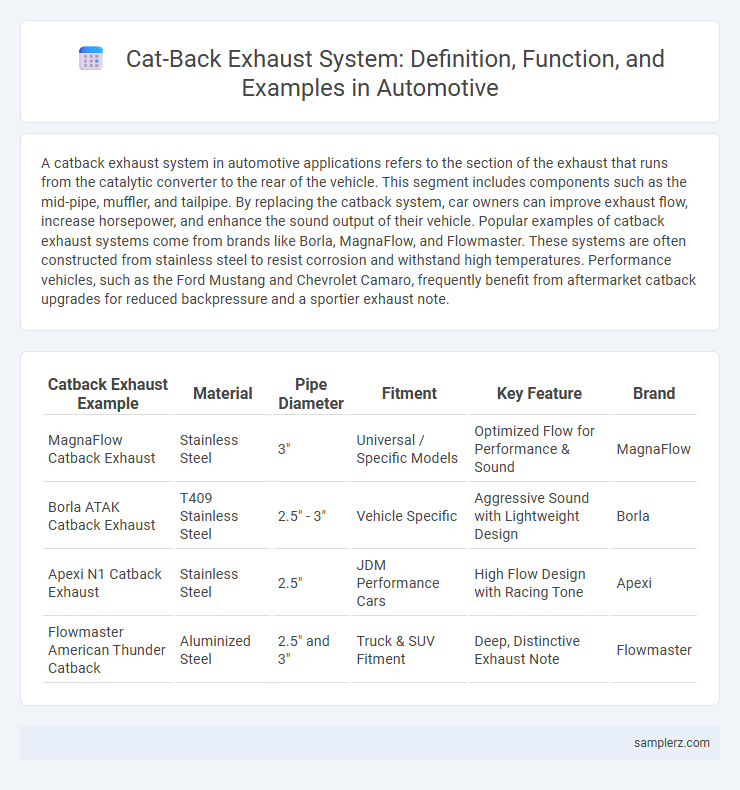A catback exhaust system in automotive applications refers to the section of the exhaust that runs from the catalytic converter to the rear of the vehicle. This segment includes components such as the mid-pipe, muffler, and tailpipe. By replacing the catback system, car owners can improve exhaust flow, increase horsepower, and enhance the sound output of their vehicle. Popular examples of catback exhaust systems come from brands like Borla, MagnaFlow, and Flowmaster. These systems are often constructed from stainless steel to resist corrosion and withstand high temperatures. Performance vehicles, such as the Ford Mustang and Chevrolet Camaro, frequently benefit from aftermarket catback upgrades for reduced backpressure and a sportier exhaust note.
Table of Comparison
| Catback Exhaust Example | Material | Pipe Diameter | Fitment | Key Feature | Brand |
|---|---|---|---|---|---|
| MagnaFlow Catback Exhaust | Stainless Steel | 3" | Universal / Specific Models | Optimized Flow for Performance & Sound | MagnaFlow |
| Borla ATAK Catback Exhaust | T409 Stainless Steel | 2.5" - 3" | Vehicle Specific | Aggressive Sound with Lightweight Design | Borla |
| Apexi N1 Catback Exhaust | Stainless Steel | 2.5" | JDM Performance Cars | High Flow Design with Racing Tone | Apexi |
| Flowmaster American Thunder Catback | Aluminized Steel | 2.5" and 3" | Truck & SUV Fitment | Deep, Distinctive Exhaust Note | Flowmaster |
What Is a Catback Exhaust System?
A catback exhaust system includes all components from the catalytic converter to the rear of the vehicle, improving exhaust flow and enhancing engine performance. It typically consists of a pipe, muffler, and exhaust tips, designed to reduce backpressure and increase horsepower. This system not only boosts sound quality but also contributes to better fuel efficiency and a sportier appearance.
Key Components of a Catback Exhaust
A typical catback exhaust system includes three key components: the mid-pipe, the muffler, and the tailpipe. The mid-pipe connects the catalytic converter to the muffler, optimizing exhaust flow and improving engine performance. The muffler reduces noise levels while the tailpipe directs exhaust gases away from the vehicle, enhancing both sound quality and aesthetic appeal.
Benefits of Upgrading to a Catback System
Upgrading to a catback exhaust system enhances vehicle performance by improving exhaust flow, which increases horsepower and torque. This modification also delivers a deeper and more aggressive exhaust note, contributing to a sportier driving experience. Furthermore, catback systems are designed to be a direct fit, making installation straightforward while providing weight reduction compared to stock exhaust components.
Popular Catback Exhaust Brands
Popular catback exhaust brands in the automotive industry include Borla, Flowmaster, and MagnaFlow, known for enhancing vehicle performance and sound quality. Borla specializes in 100% stainless steel systems with aggressive sound profiles, while Flowmaster is praised for its distinctive rumble and durability. MagnaFlow offers a blend of performance gains and deep tone, making these brands top choices for enthusiasts upgrading their exhaust systems.
Performance Gains With Catback Installations
Installing a catback exhaust system can significantly improve horsepower and torque by reducing backpressure and enhancing exhaust flow. High-quality catback setups made from stainless steel or mandrel-bent piping optimize sound and increase engine efficiency. Performance gains typically range from 5 to 15 horsepower, depending on the vehicle and tuning.
Material Choices: Stainless Steel vs. Aluminized Catbacks
Stainless steel catback exhaust systems offer superior resistance to corrosion and high-temperature durability compared to aluminized steel, making them ideal for long-term performance in automotive applications. Aluminized catbacks provide a cost-effective alternative with decent rust protection due to their aluminum-silicon alloy coating but may degrade faster under harsh environmental conditions. Choosing stainless steel enhances exhaust longevity and maintains optimal sound quality, especially in performance vehicles requiring robust material integrity.
Sound Differences: Stock vs. Catback Exhaust
A catback exhaust system replaces the piping from the catalytic converter to the rear of the vehicle, offering a significant improvement in exhaust flow and sound compared to the stock system. Stock exhausts are typically designed for noise reduction and compliance with emissions regulations, resulting in a quieter and more muted engine sound. Catback exhausts produce a deeper, more aggressive tone by reducing backpressure, enhancing engine acoustics and driving experience.
Installation Process for Catback Systems
The installation process for catback systems typically involves removing the factory exhaust components from the catalytic converter to the muffler and replacing them with aftermarket piping and mufflers designed for improved performance and sound. It requires tools such as wrenches, jack stands, and penetrating oil to loosen rusted bolts and clamps, ensuring a secure fit and proper alignment to prevent leaks or rattles. Professional installation may optimize vehicle horsepower gains and exhaust flow efficiency by ensuring correct sensor placement and avoiding damage to emission control devices.
Top Catback Exhaust Examples for Popular Cars
Top catback exhaust examples for popular cars include the Borla ATAK Cat-Back System known for its aggressive sound and improved airflow on the Ford Mustang GT. The MagnaFlow Street Series Cat-Back exhaust enhances performance and delivers a deep tone for the Chevrolet Camaro SS. For Subaru WRX owners, the COBB Tuning Catback exhaust provides optimized backpressure and a distinctive growl, boosting both horsepower and torque.
Maintenance Tips for Catback Exhaust Longevity
Regularly inspecting the catback exhaust system for rust and leaks can prevent costly repairs and ensure optimal performance. Applying high-temperature anti-seize lubricant on bolts and using corrosion-resistant hangers extend the exhaust's lifespan. Periodic cleaning of the exhaust pipes with a metal polish protects against corrosion and maintains a polished appearance.

example of catback in exhaust Infographic
 samplerz.com
samplerz.com